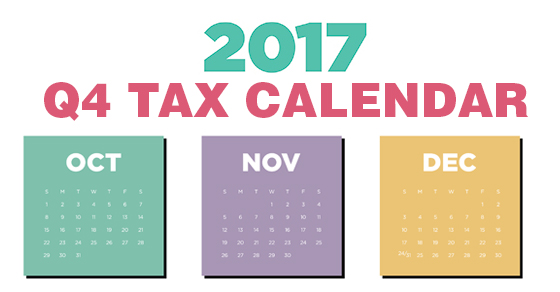Weekly Tax Brief
The ins and outs of tax on “income investments”
- Details
- Published: 31 October 2017 31 October 2017

Many investors, especially more risk-averse ones, hold much of their portfolios in “income investments” — those that pay interest or dividends, with less emphasis on growth in value. But all income investments aren’t alike when it comes to taxes. So it’s important to be aware of the different tax treatments when managing your income investments.
Retirement savings opportunity for the self-employed
- Details
- Published: 25 October 2017 25 October 2017

Did you know that if you’re self-employed you may be able to set up a retirement plan that allows you to contribute much more than you can contribute to an IRA or even an employer-sponsored 401(k)? There’s still time to set up such a plan for 2017, and it generally isn’t hard to do. So whether you’re a “full-time” independent contractor or you’re employed but earn some self-employment income on the side, consider setting up one of the following types of retirement plans this year.
Read more: Retirement savings opportunity for the self-employed
2 ACA taxes that may apply to your exec comp
- Details
- Published: 19 October 2017 19 October 2017

If you’re an executive or other key employee, you might be rewarded for your contributions to your company’s success with compensation such as restricted stock, stock options or nonqualified deferred compensation (NQDC). Tax planning for these forms of “exec comp,” however, is generally more complicated than for salaries, bonuses and traditional employee benefits.
Accelerate your retirement savings with a cash balance plan
- Details
- Published: 16 October 2017 16 October 2017

Business owners may not be able to set aside as much as they’d like in tax-advantaged retirement plans. Typically, they’re older and more highly compensated than their employees, but restrictions on contributions to 401(k) and profit-sharing plans can hamper retirement-planning efforts. One solution may be a cash balance plan.
Read more: Accelerate your retirement savings with a cash balance plan
“Bunching” medical expenses will be a tax-smart strategy for many in 2017
- Details
- Published: 03 October 2017 03 October 2017

Various limits apply to most tax deductions, and one type of limit is a “floor,” which means expenses are deductible only if they exceed that floor (typically a specific percentage of your income). One example is the medical expense deduction.
Read more: “Bunching” medical expenses will be a tax-smart strategy for many in 2017
Why you should boost your 401(k) contribution rate between now and year end
- Details
- Published: 19 September 2017 19 September 2017

One important step to both reducing taxes and saving for retirement is to contribute to a tax-advantaged retirement plan. If your employer offers a 401(k) plan, contributing to that is likely your best first step.
Read more: Why you should boost your 401(k) contribution rate between now and year end
2017 Q4 tax calendar: Key deadlines for businesses and other employers
- Details
- Published: 12 September 2017 12 September 2017

Here are some of the key tax-related deadlines affecting businesses and other employers during the fourth quarter of 2017.
Read more: 2017 Q4 tax calendar: Key deadlines for businesses and other employers
Watch out for potential tax pitfalls of donating real estate to charity
- Details
- Published: 06 September 2017 06 September 2017

Charitable giving allows you to help an organization you care about and, in most cases, enjoy a valuable income tax deduction. If you’re considering a large gift, a noncash donation such as appreciated real estate can provide additional benefits. For example, if you’ve held the property for more than one year, you generally will be able to deduct its full fair market value and avoid any capital gains tax you’d owe if you sold the property. There are, however, potential tax pitfalls you must watch out for:
Read more: Watch out for potential tax pitfalls of donating real estate to charity
The ABCs of the tax deduction for educator expenses
- Details
- Published: 29 August 2017 29 August 2017

At back-to-school time, much of the focus is on the students returning to the classroom — and on their parents buying them school supplies, backpacks, clothes, etc., for the new school year. But let’s not forget about the teachers. It’s common for teachers to pay for some classroom supplies out of pocket, and the tax code provides a special break that makes it a little easier for these educators to deduct some of their expenses.
Read more: The ABCs of the tax deduction for educator expenses
Yes, you can undo a Roth IRA conversion
- Details
- Published: 23 August 2017 23 August 2017

Converting a traditional IRA to a Roth IRA can provide tax-free growth and the ability to withdraw funds tax-free in retirement. But what if you convert a traditional IRA — subject to income taxes on all earnings and deductible contributions — and then discover that you would have been better off if you hadn’t converted it? Fortunately, it’s possible to undo a Roth IRA conversion, using a “recharacterization.”





